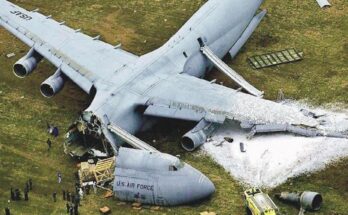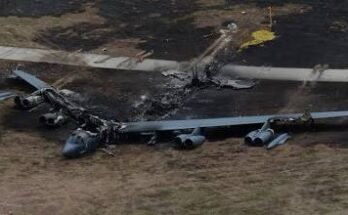
Crash of a Lockheed C-5B Galaxy at Dover AFB: A Close Call in Military Aviation
The Lockheed C-5B Galaxy, one of the largest military transport aircraft in the world, has long been a symbol of the U.S. Air Force’s logistical capabilities. However, on a fateful day at Dover Air Force Base (AFB), this massive aircraft was involved in a catastrophic crash that could have ended in an even greater tragedy. The incident, though alarming, provided crucial lessons on aviation safety, aircraft maintenance, and emergency response.
The Lockheed C-5B Galaxy: A Military Workhorse
The C-5B Galaxy is a heavy strategic airlifter designed to transport oversized cargo and personnel across vast distances. Introduced in the late 1980s as an upgraded version of the original C-5A, the aircraft features enhanced avionics, improved engines, and greater reliability. Capable of carrying tanks, helicopters, and even other aircraft parts, the C-5B plays a crucial role in military operations worldwide.
Despite its impressive track record, the C-5B, like any aircraft, is susceptible to mechanical failures, pilot errors, and unforeseen circumstances that can lead to accidents. The crash at Dover AFB became a case study in how a combination of factors can lead to disaster, even for the most experienced crews.
The Events Leading to the Crash
On the day of the crash, the C-5B was conducting a routine mission when things took a turn for the worse. Shortly after takeoff, the aircraft began experiencing serious mechanical issues, prompting the crew to attempt an emergency landing at Dover AFB.

Eyewitnesses and flight data indicated that the plane struggled to maintain stability, and as it approached the runway, it became clear that the landing would be anything but routine. The aircraft descended rapidly, hitting the ground with significant force. The impact caused severe damage to the fuselage, wings, and landing gear, splitting the aircraft into multiple sections.
The Aftermath: A Miracle Survival
Despite the catastrophic nature of the crash, remarkably, there were no fatalities among the crew members. While some sustained injuries, all personnel on board survived—a rare outcome in aviation accidents of this magnitude. This was largely credited to the aircraft’s robust design, quick response from emergency teams, and the crew’s adherence to safety procedures.
The survival of those on board was seen as a testament to the effectiveness of military training and emergency preparedness. It also highlighted the importance of having well-practiced evacuation plans and safety measures in place.
Investigating the Cause of the Crash
Following the crash, an extensive investigation was launched to determine what went wrong. Key findings pointed to a combination of factors, including:
1. Engine Failure: One of the aircraft’s engines reportedly experienced a malfunction, leading to power loss. Given the massive size of the C-5B, engine performance is critical, and a failure can significantly impact maneuverability.
2. Flight Control Issues: Investigators discovered that control system malfunctions may have contributed to the pilots’ difficulty in stabilizing the aircraft.
3. Human Factors: While the crew was highly trained, the stress of an emergency situation can lead to split-second decisions that may not always be optimal. The investigation examined whether pilot actions played a role in how the situation unfolded.
4. Structural Stress and Landing Dynamics: The aircraft’s landing approach was analyzed to determine if excessive stress on the airframe contributed to the breakup upon impact.
Lessons Learned and Safety Improvements
The crash of the C-5B at Dover AFB prompted several changes in maintenance procedures, training protocols, and operational guidelines, including:
• Enhanced Engine Inspections: Routine maintenance procedures were updated to detect early signs of mechanical failure in the aircraft’s engines.
• Advanced Flight Simulations: Military pilots began receiving more comprehensive emergency scenario training to improve their ability to handle unexpected failures.
• Improved Communication Protocols: Clearer guidelines for in-flight emergency communication were established to ensure that flight crews receive immediate support from ground control.
The accident served as a wake-up call, emphasizing the need for constant vigilance in aircraft maintenance and flight operations.
Aviation Safety and Military Readiness
While the C-5B crash was a dramatic and costly incident, it also reinforced the resilience of the U.S. Air Force’s aviation safety measures. The ability of the crew to survive, despite the odds, underscored the effectiveness of military training and the importance of well-maintained aircraft.
Incidents like this remind military and civilian aviation experts alike that while air travel is one of the safest modes of transportation, it is never without risk. Continuous improvements in technology, training, and safety protocols remain essential in preventing similar accidents in the future.

Conclusion
The crash of the Lockheed C-5B Galaxy at Dover AFB was a near-tragic event that could have been far worse. While the aircraft was severely damaged, the survival of all crew members was a testament to the effectiveness of emergency preparedness and aircraft engineering.
The lessons learned from this accident continue to influence aviation safety practices, ensuring that pilots, maintenance crews, and air traffic controllers remain equipped to handle even the most challenging situations. The legacy of this crash is one of resilience, adaptation, and a commitment to making military aviation safer for the future.


